You are viewing 1 of your 1 free articles
Simple pressing as a team
| Area | Up to a full pitch |
| Equipment | Balls, cones, goals, target goals |
| No. of Players | Up to 11v11 |
| Session Time | Shape line pressing drill 10mins, 8v6 20mins, 10v10 (plus keeper) phase 20mins, 11v11 game 30mins |
This session teaches players simple tactical understanding for pressing as a team. It’s important to practise this because pressing forces mistakes in opposition build-up play, particularly in sides who like to pass the ball out from the back. That means, in the context of a game, we can gain or change momentum.
The session acts as an excellent practice for all team members. Even outside of pressing, it coaches stamina, communication and concentration.
And it should be remembered, the physical demands of pressing are paid back by teams winning the ball high up the pitch – in other words, already in danger areas. That means a quicker creation of chances and the retaining of momentum.
What do I get the players to do?
Shape pressing line drill
Setting up as shown on a half pitch, a defender in the back four receives from the keeper then passes two-touch across the back four, with the ball moving left and right (1a).
1a
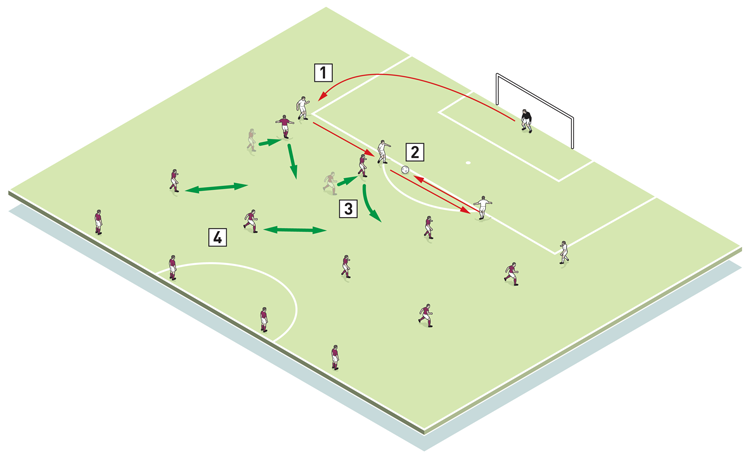
2. The ball is worked left and right across the defensive line
3. Pressing players in the top line move in to close down then drop back
4. Behind, the midfielders react to the pressing players’ movement
The trigger player starts the press - the pressing line works by shuffling and sliding in relation to the position of the ball, but players do not tackle, they merely work together in forming a strong pressing line. Non-pressing players in the line must drop off, ready to move forward should the player in position send the ball to a team mate. Behind them, the defensive line subsequently shuffles and slides as well.
After a time period to be designated by the coach – we would recommend a minimum of one minute – the defensive back four jogs out to the rest line (1b). The team who were at the front pressing line now turn around and become defenders, receiving a pass from the keeper to begin, as the move is repeated.
1b
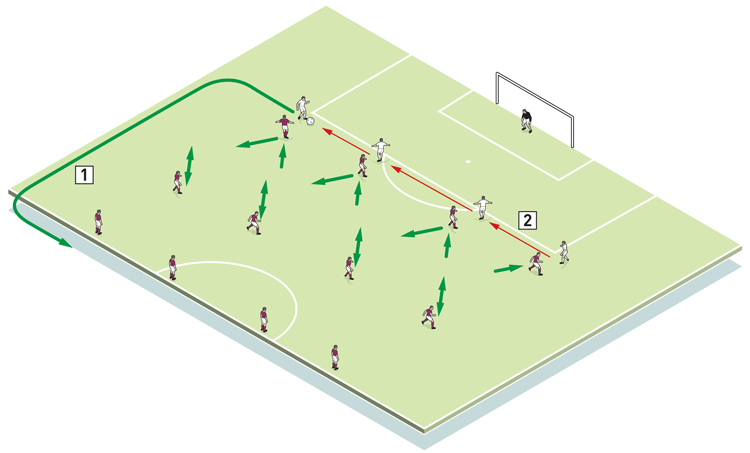
2. Pressing line players now become defenders and will receive the ball off the keeper
8v6 phase
Now set up 8v6, as shown (2), as the defending team (of eight players) begins by being fed the ball by the keeper. The aim here is to move the ball upfield and score in any one of the three small goals. The attacking team of six must score in the big goal.
2
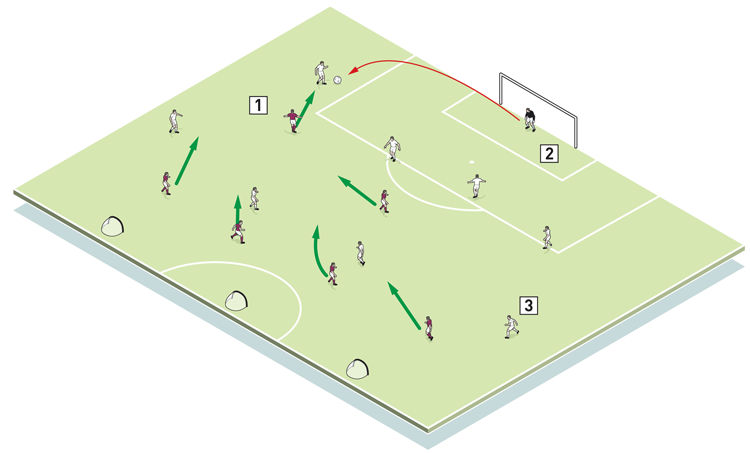
2. The keeper feeds the ball to a defender
3. Defensive players track the path of the ball and the two attackers
We want to encourage the two centre-forwards to compress, giving their midfield line of four time to adjust in taking up good supporting pressing positions.
Again, two-touch conditions can be applied to the defenders in order to encourage attackers to press. We would then remove these conditions to see how players react to the change.
10v10 (plus keeper) phase
This is a new set-up which means us extending the pitch length by 20 yards. It’s now 4-4-2 versus 4-4-2, so an equal two-way practice in terms of team size, although each side still has to attack different types of goals (3).
3
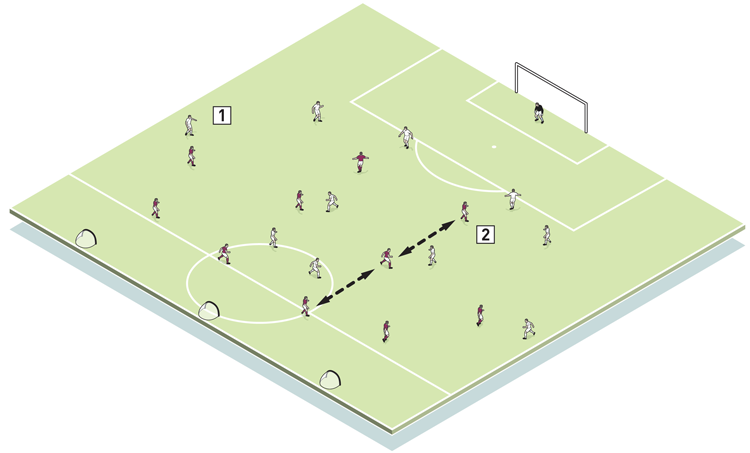
2. Defenders must make maximum use of the pitch to ensure they can press quickly and positively
11v11 game
We now move onto a full pitch (4a). Sideways distances between the back four remain the same, but due to the lengthened pitch we now want to see players showing awareness too of distances between the lines.
4a
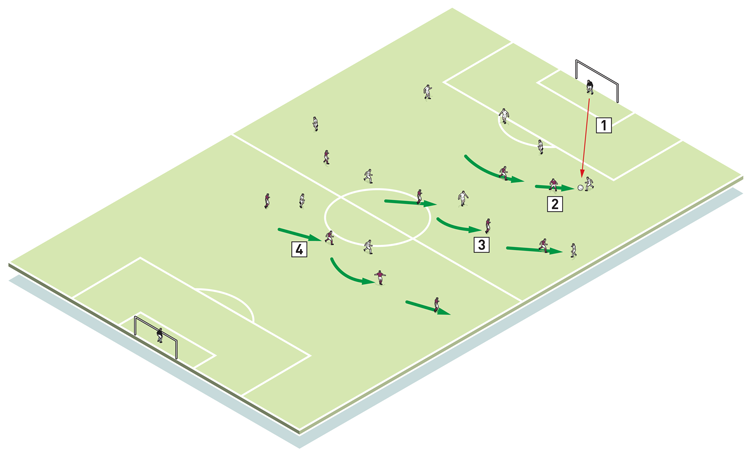
2. Attackers move in to press
3. Midfielders follow the movement
4. Defensive players also shuffle across but keep their shoulders side-on so that they can remain reactive to a long ball
In the 11v11 we are also working even more closely on the trigger, namely the player who starts the press. This could be the wide man, the centre-forward, or anyone else. Again, players must shuffle and slide as a team, but must be compact within this shape.
We look too for recovery lines to be adhered to if the press is beaten (4b).
4b

2. His pressing opponent is quick to close down the space
3. Midfielders also reduce available space in the centre
4. Fellow defenders prepare to cover the space in behind
What are the key things to look out for?
In each set-up, the key directives are pressing, team shape, keeping the same side as the ball, and maintaining good distances between team members in each back four – this, ideally, will be a distance that can be covered in two strides.Players must have front foot thinking, always ready to move forward quickly in order to close down or receive the ball.
Players operating in the back four should have their shoulders side-on in case of a long ball being played forward.
Related Files
Editor's Picks
Intensive boxes drill with goals
Penetrating the final third
Creating and finishing
My philosophy
Pressing initiation
Compact team movement
Defensive organisation
Back three tactics
Counter-pressing as an offensive weapon
Coaches' Testimonials

Alan Pardew

Arsène Wenger

Brendan Rodgers

Carlos Carvalhal

José Mourinho

Jürgen Klopp

Pep Guardiola

Roy Hodgson

Sir Alex Ferguson

Steven Gerrard
Coaches' Testimonials

Gerald Kearney, Downtown Las Vegas Soccer Club

Paul Butler, Florida, USA

Rick Shields, Springboro, USA

Tony Green, Pierrefonds Titans, Quebec, Canada
Join the world's leading coaches and managers and discover for yourself one of the best kept secrets in coaching. No other training tool on the planet is written or read by the calibre of names you’ll find in Elite Soccer.
In a recent survey 92% of subscribers said Elite Soccer makes them more confident, 89% said it makes them a more effective coach and 91% said it makes them more inspired.
Get Monthly Inspiration
All the latest techniques and approaches
Since 2010 Elite Soccer has given subscribers exclusive insight into the training ground practices of the world’s best coaches. Published in partnership with the League Managers Association we have unparalleled access to the leading lights in the English leagues, as well as a host of international managers.
Elite Soccer exclusively features sessions written by the coaches themselves. There are no observed sessions and no sessions “in the style of”, just first-hand advice delivered direct to you from the coach.








